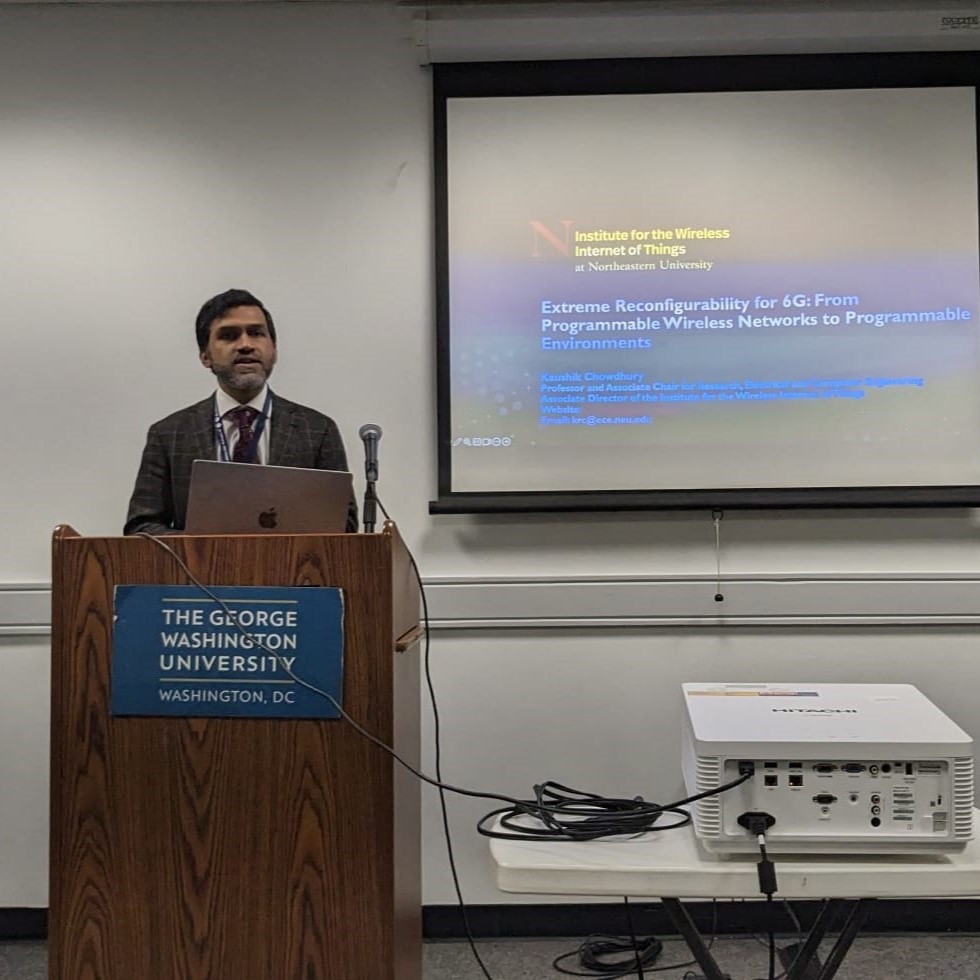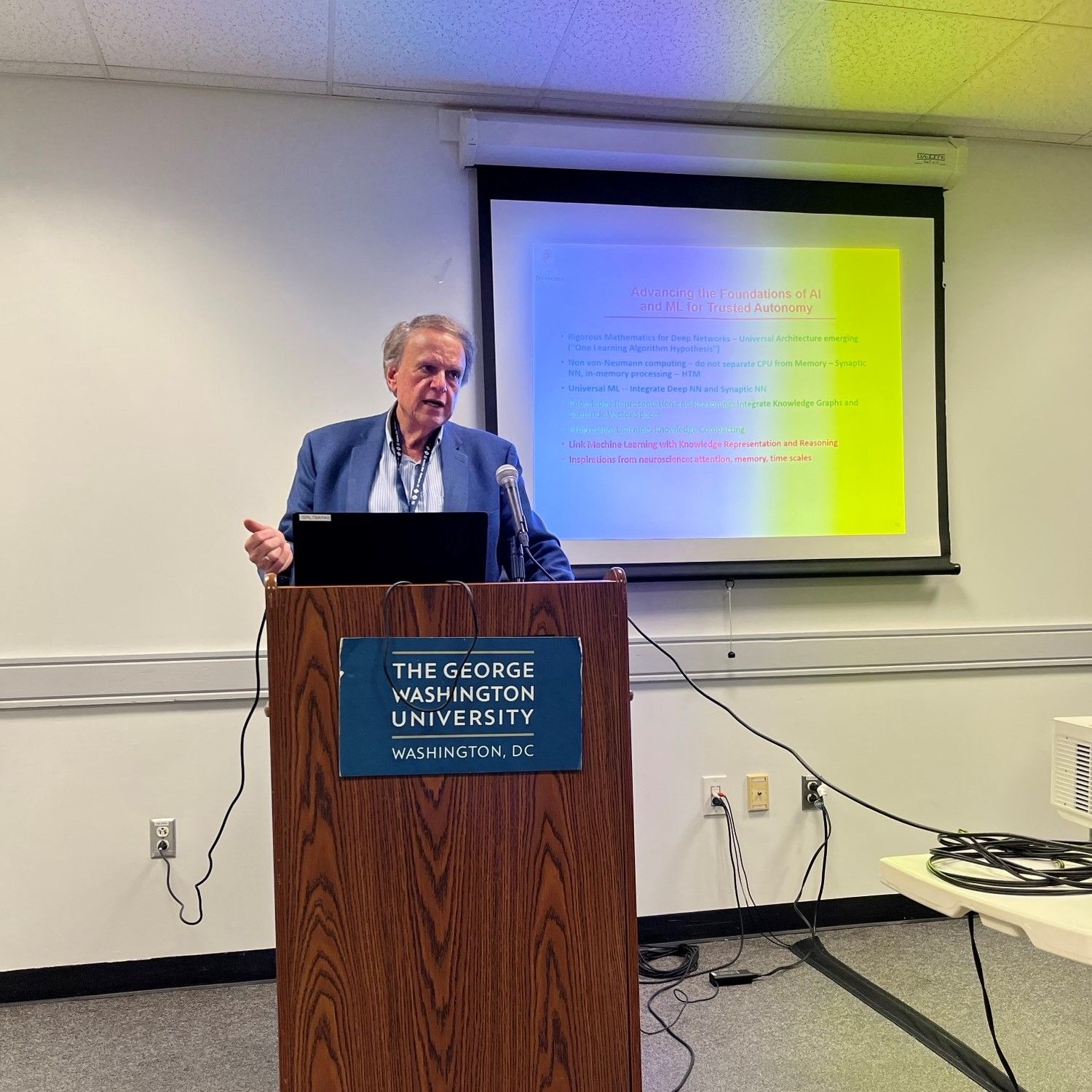International Day of Women and Girls in Science 2024
The 11 February marks the International Day of Women and Girls in Science. A milestone adopted in 2013 by the UN General Assembly to recognise that "full and equal access to and participation in science, technology and innovation for women and girls of all ages is imperative for achieving gender equality and the empowerment of women and girls".
In PREDICT-6G, as could not be otherwise, we join the UN declaration. Our consortium works towards the advancement of real equality within the academic and scientific world and ultimately, the society.
To understand better why this day is necessary, we refer to some data:
- According to UIS data, less than 30% of the world’s researchers are women.
- While women represent 33.3% of all researchers, only 12% of members of national science academies are women, says the UN.
- According to the UN, female researchers tend to have shorter, less well-paid careers. Their work is underrepresented in high-profile journals and they are often passed over for promotion.
In the European Union, the European Institute for Gender Equality (EIGE) statistics underline the “glass ceiling” continues to be very present. Women in academic and research represent 42% of the total staff and the number only decreases as seniority increases, including the presence of women in decision-making positions. They also receive less research funding, have less papers and inventorships. Contrariwise, women are a majority in terms of part-time and precarious work.
To celebrate, and also vindicate this day, PREDICT-6G interviewed Carla Fabiana Chiasserini, Full Professor at Politecnico di Torino and our consortium partner.
Q: What do you like most about your work as a scientist?
A: To be creative, envisioning new solutions. And, before that, to spot interesting aspects and pose problems whose solution can lead to technological advancements and have an impact on our daily life. It is always a challenge, but it’s what makes the work of a scientist exciting.
Q: Who were and are your female referents in the scientific world?
A: I learn something every time I meet and interact with a colleague. That said, I usually have lots to share with female researchers and lots to learn from them, from all of them, they are simply amazing.
Q: What advice would you give to a little girl who wants to pursue a career in science?
A: I can only encourage her to pursue it, and try and explore as many unexplored paths as possible. Not to fear them and not to get discouraged ever, mishaps of any kind are just part of the game.
If you want to stay updated about PREDICT-6G, subscribe to our newsletter and follow us on Twitter and LinkedIn!
One year of PREDICT-6G: 2023 review
By Antonio de la Oliva, Project Coordinator
The end of 2023 marks also the closing of the first year of the PREDICT-6G project. During this year, several key milestones have been achieved, setting the basis for the technical work of the second year. During the first months of 2023, PREDICT-6G focused on understanding the use cases which may benefit from deterministic networking innovations. The three use cases defined in the proposal - Smart manufacturing, Deterministic services for critical communications and multi-domain deterministic communications - have been extended to Localisation and Sensing, XR and IETF RAW and DetNet. With the inclusion of these new use cases, we believe the project sufficiently covers the requirements of current industries.
Based on the requirements and expected KPIs of the identified use cases, the main efforts of the year 2023 were dedicated to developing the system architecture and the principles of the Multi-Domain Dataplane (MDP) in WP2 and the AI-driven multi-stakeholder inter-domain Control Plane (AICP) in WP3. The work on the MDP and AICP design was synthetised into a full architecture specification, including E2E and domain level management service definition, E2E deterministic service architecture and lifecycle, MDP architecture and cross-domain U-plane integration enablers, system and service procedures, and Open APIs for technology integration with 3GPP and IETF DetNet domains.
Regarding the MDP, innovation areas were explored in the data-plane to enable cross-domain deterministic services, such as deterministic service continuity at domain borders, deterministic scheduler designs, cross-domain split of reliability and deterministic enablers, and time sync across multiple domains. Technologies consider 3GPP (with and without IETF DetNet integration support), IEEE TSC (with IETF DetNet), and novel Wi-Fi MAC capabilities. To support these technologies at the control level, the project follows an OpenAPI methodology defining the programmability layer on top of a network segment with the selected deterministic technologies, or even over network domains with no explicit support for determinism. The OpenAPIs are the interface between the PREDICT-6G MDP and AICP, enabling the technology-agnostic design for the AICP architecture. Current discussion within the project is the relation of the OpenAPIs with the DetNet component, and whether all different domains should be integrated below the DetNet control.
At its own pace, the AICP has also evolved significantly during 2023. The AICP follows a service-based architecture principle, where Management Services (MS) interact with each other via clearly defined APIs. MSs that share the same management scope are organised into Management Domains (MD). AICP defined a single MD for the E2E deterministic services, as well as separate MDs for each of the technology domains that are part of the initial release of PREDICT-6G’s MDP. This role split enables the AICP to govern any number of technological domains (i.e., 3GPP, IETF DetNet / IEEE TSN, Wi-Fi, and more) driven by the same end-to-end service focus. Individual Management Services implement capabilities such as service ingestion, service automation, path computation, digital twinning, AI-based predictions, measurement collection, and the exposure of topology, services, resources, and capabilities from domain level to end-to-end and from end-to-end to the consumer (e.g., user, operator) of PREDICT-6G.
At the end of 2023, the project also started the development and integration activities. Led by WP4, the first step was to define the methodology (sprint based agile development and integration cycles) and timeline for developing, integrating, and validating the PREDICT-6G system components. The design of Open Labs and the structure of the validation tests have also been central in this first year.
In conclusion, although the project is still in its infancy, we have a clear view on its merits and innovations, and the consortium is focused on achieving great impact in the industry, developing new technologies to create new deterministic networks.
Assessment of the first year of the project from the Partners' perspective
The PREDICT-6G consortium consists of 17 partners from seven countries working together to develop a multi-technology, multi-domain data plane that revises the reliability and time-sensitive design features existing in current wired and wireless standards.
While we all work towards a common goal, each partner has a specific role with concrete milestones. Thus, we have asked them about the highlights of PREDICT´s first year and what they expect to achieve in 2024.
UNIVERSIDAD CARLOS III DE MADRID
At UC3M, we have been mostly focused on developing several components of the MDP, specially on developing an open source XDP based bridge, which can be used to develop novel scheduling policies. We have also deployed multiple technologies to start building the MDP, including Wireless TSN, Ethernet-based TSN, Open Air interface 5G network, and programmable P4 switches.
During the second year of the project, through this infrastructure, we will focus on developing the WP3 components and prove the new approaches for the PREDICT-6G data plane.
In the first year of PREDICT-6G, ATOS+ATOSP’s main focus was the design of the AI-driven Inter-domain Control-Plane (AICP). In particular, ATOS+ATOSP led the efforts related to the architecture design of the inter-domain and network control mechanisms, assuming the responsibility of defining Service Automation Management Services. Additionally, the company was an active contributor to the composition of the AI/ML layout, taking the lead in the development of the AI/ML framework, which will be used by the project as the basis for building complex AI/ML algorithms.
Looking towards PREDICT-6G second year, ATOS+ATOSP will concentrate their efforts in the implementation of the Service Automation and the AI/ML framework modules, which are considered core services for showcasing the potential of the AICP in PREDICT-6G Proof-of-Concepts (PoCs).
This year was very important for partners to build a close relationship that would underpin all the project work, including the implementation of communication and dissemination strategy. Consolidating the PREDICT-6G branding, setting up the digital tools - website and social media - and overall, positioning the project in the SNS JU, were some of the main accomplishments in the last 12 months. Moreover, AUSTRALO established the first contacts with relevant stakeholders in the SNS community with very positive results.
In Year 2, AUSTRALO will continue to foster the PREDICT-6G community. In addition to the communication activities, the engagement with relevant stakeholders through targeted actions will accelerate to ensure the impact of the project. The dissemination of outcomes, as PREDICT-6G matures and the first results emerge, will be one of the priorities. We expect to support PREDICT-6G to become a reference in the SNS system architecture.
During the first year of PREDICT-6G, our main objective and area of work has been to identify security threats to predictive, multi-domain and technological 6G mobile networks, and corresponding challenges that need to be assessed through specific mechanisms and protocols. Following the completion of this work, next year we will focus on designing and developing mechanisms and protocols to provide the necessary security solutions.
CONSIGLIO NAZIONALE DELLE RICERCHE
In this first year, the CNR activities started with a comprehensive exploration of the State of the Art (SoA) in deterministic networks, with specific focus on Time-Sensitive Networking (TSN). The primary goal was to identify an effective methodology for assessing the performance of this emerging technology, particularly in terms of latency and jitter. Collaborative efforts were undertaken with all project partners to establish the architecture and define relevant case studies. In this sense, the definition of automation and robotics scenarios in line with the PREDICT-6G industrial case studies was done so as to allow gaining insight into the TSN application to information spreading and edge computing.
Subsequently, CNR people conceptualised a sophisticated software architecture designed to evaluate latencies in both individual devices and network infrastructures, incorporating scenarios with and without running synchronisation systems. At the same time, rigorous prototype implementation and test activities were conducted to assess TSN performance over WiFi. To this regard, some preliminary results of such activities have been presented in a paper published in the Proceedings of the IEEE ETFA 2023 International Conference.
In 2024, the CNR will investigate the framework described above to assess the performance of devices and analyse the results to create virtual counterparts for use in the Digital Twin. Installing a prototype hybrid wired/wireless/5G network to conduct test campaigns on the components of the PREDICT-6G architecture.
To perform realistic simulations of sensitive scenarios to study useful scaling laws and suggest control strategies to improve performance in deterministic communication and task completion.
In the first year of the project, the team dedicated their efforts to several key initiatives. A primary focus was the in-depth study and analysis of the Smart Factory use case. Internal workshops played a crucial role in establishing a first draft of the architecture framework needed for said use case. The project achieved a significant milestone with the delivery of D1.1, titled "Analysis of use case and system requirements." Additionally, the team delineated the requirements for both the Multi Data Plane (MDP) and the Control Plane.
As the project advances into its second year, the central emphasis shifts towards the design of the use case integration. This will be accompanied by the inaugural testing of the use case within the 5TONIC Open Lab. The outcomes of these tests will be documented to facilitate further experimentation and analysis in subsequent phases.
During the first year, the Consortium helped to define the architecture and interfaces between the AI-based control plane and the data plane innovations (e.g., exploitation of new Wi-Fi features for improved determinism). This outcome was a product of a dialog between experts in determinism in the different wired and wireless domains, addressing the challenges to integrate the available options in 3GPP, IEEE and IETF standards.
The implementation and integration of technologies in the testbed such as Wi-Fi based TSN, as well as E2E and domain-specific management services such as AI-based slicing will be central in 2024. The evaluation of the target KPIs defined in the project can then be assessed.
Working with so many talented individuals and impactful organisations towards the definition of deterministic communications in 6G has been the highlight of the first year.
In Year 2, InterDigital will prove the novel concept of Data Unit Groups,. This extension to IP headers will allow to treat a set of packets carrying a single Application Data Unit collectively, e.g. to map the information inside the IP header extensions to PDU Set Markers in 3GPP networks or to place them into specific TSN switch queues and/or to pre-empt them if deemed necessary to guarantee their QoS constraints. This innovation will be demonstrated an Integrated Sensing and Communication use case. 5TONIC serves as the TRL4 environment to validate the proof-of-concept.
The first year started in-depth analysis of the technical requirements imposed by the three use cases that will be demonstrated at the end of the project and the subsequent design of the system architecture. This was a huge work that was split in two parts: one focusing on the data-plane, and another on the control/management-plane. This design resulted in a PREDICT-6G architecture that is modular, with clear separation between technology domain management and end-to-end service management, which in turn enables extendibility to any new network technology without changing end-to-end principles.
The realisation of all PREDICT-6G components and their integration into a coherent system will be the priority in 2024. The implementation work has already started on a small scale, with a few code drops delivered at the end of 2023.
As far as POLITO activity was concerned, the first year of the project has been marked by acquiring competence in creating seamless deterministic services across network domains, employing a blend of telecommunications standards and innovative Wi-Fi technologies, all unified under a flexible OpenAPI-driven control architecture.
The main focus of the second year will be on providing deterministic guarantees in WiFi networks by exploring the potential of a comprehensive 802.11 scheduler that incorporates time, frequency, and space dimensions, with an emphasis on dynamic adaptation to variable traffic and radio channels. The objective will be to efficiently allocate deterministic traffic while maximising throughput for other traffic, incorporating frequent scheduling updates and considering the integration of preamble puncturing for future-proofing against emerging WiFi standards.
UNIVERSITAT POLITÈCNICA DE CATALUNYA
In its inaugural year, the UPC group achieved significant milestones in different key areas: dynamic scheduling for radio resource management in mixed traffic types for private 5G networks, and AICP Management Services (MSs) to support E2E services provisioning and maintenance.
Dynamic Scheduling for Radio Resource Management in Mixed Traffic Types for Private 5G Networks involved substantial progress in the domain of dynamic scheduling and OFDMA radio resource management in the context of mixed traffic types (Isochronous TSN, Asynchronous TSN and Best Effort (BE)) within private 5G networks deployed in industrial settings. This entails the effective allocation of resources and admission control in response to the varying communication demands of diverse traffic types. The outcomes of this effort include improved spectral efficiency, reduced latency/jitter and enhanced reliability, all crucial factors for the successful integration of 5G technologies in private networks and the support of a range of applications in the industrial domain.
On the other hand, UPC actively contributed to the design and preliminary implementation of AICP MSs, such as Digital Twin for KPI evaluation and Path Computation, both at technology domain level and at the E2E level. Both MSs are essential for the deterministic services provisioning assuring their requirements and represent significant components of the PREDICT-6G AICP.
In conclusion, the first year has been marked by commendable progress. These achievements reflect the initiative's commitment to advancing research in the field of deterministic services, laying a solid foundation for continued exploration and innovation in the months to come.
Building on the achievements of the first year, the second year of PREDICT-6G considers the following focused areas to further advance the research and development:
- Advanced Dynamic Scheduling and Resource Management in Mobility Scenarios: This involves refining and enhancing dynamic scheduling algorithms for radio resource management, placing a particular emphasis on the allocation of resources in mobility scenarios where handovers should not affect the continuity of the service. To that end, we will consider the resource allocation for the Dual Active Stack Protocol handover. We will incorporate machine learning techniques to enable the network to adapt to UL/DL traffic variability and learn from dynamic industrial environments, ensuring improved performance.
- Development and integration of a Digital Twin module for KPI evaluation as part of the AICP.
- Development and integration of a Path Computation modules as part of the AICP.
- Integration on the Advanced Dynamic Scheduling and Resource Management in the Digital Twin: Explore the integration of the studied technologies to augment the capabilities through the integration of the schedulers in the E2E digital twin tool. Investigate how these technologies can synergize with dynamic scheduling approaches to enhance reliability, latency and real-time decision-making about the admission and rejection of traffic flows.
- Standardisation and Industry Adoption: Engage with pre-standardization bodies and industry stakeholders to contribute insights and findings to the development of 6G standards.
If you want to stay updated about PREDICT-6Gt, subscribe to our newsletter and follow us on Twitter and LinkedIn!
Let’s review what we have achieved, and where we are heading
By Péter Szilágyi, Technical Manager
Time flies so quickly when you are on a great team and working on an inspiring project! It feels like we have just started, yet it has been one whole year since PREDICT-6G kicked off. It has been a busy time, with lots of studies, planning, design, discussions, and deliverables. But the hard work has paid off: at the end of the year, we have created what we can claim to be a solid foundation of the project, both conceptually and practically. Let’s review what we have achieved, and what we are heading for, in more detail.
2023 summary
Looking back on the first year, it has been an intense study phase for the PREDICT-6G project. At the beginning, there were lots of questions around how to create multi-domain deterministic networks: what technologies to use, how to enable inter-working between different technological and administrative domains, and, above all, how to automate the service management in end-to-end so that it remains scalable to onboarding additional network technologies yet remains independent (as much as possible) from each technology’s specificities and limitations. We started the exploration by considering the technical requirements imposed by the three use cases that will be demonstrated at the end of the project. With this outcome-oriented methodology, we ensure that the PREDICT-6G system will be capable of delivering the needs of real-world scenarios. Based on the requirements, we designed the architecture of the system. This was a huge work that was split in two parts: one focusing on the data-plane, and another on the control/management-plane. These parts were investigated in parallel, but not at all in isolation: the idea was that data-plane technology enablers will be up-streamed and consolidated towards the control/management plane so that it can work on convenient abstractions instead of the raw controller layer of the L2/L3 technologies. This design resulted in a PREDICT-6G architecture that is modular, with clear separation between technology domain management and end-to-end service management, which in turn enables extendibility to any new network technology without changing end-to-end principles. The evolution of this work can be found in D1.1, D2.1 and D3.1, with D1.2 providing a standalone reference merging all PREDICT-6G architecture matters into a single document. Additionally, D2.2 and D3.2 provide reports on early implementation efforts, showing that PREDICT-6G no longer exists solely on paper but already now there is some code to be executed. Also, D4.1 reports on the integration plan that will bridge us over to the next year and set the next big piece of work in motion: the implementation of the PREDICT-6G system.
2024 outlook
A year’s start is just as good as the previous year’s end. That said, looking at the end of 2023 we have high hopes for 2024. Clearly, the biggest effort in 2024 will be the realisation of all PREDICT-6G components and their integration into a coherent system. The implementation work has already started on a small scale, with a few code drops delivered at the end of 2023, but the bulk of the work remains to be completed next year. Although we have a firm design and do not expect major changes to the architecture, experience shows that implementing a system for the first time never leaves the plans untouched, however carefully they were designed in the first place. Therefore, implementation is not going to be a one-way exercise, but it will evolve the thinking, understanding and design of the system as well. At the end, all will be for the benefit of the technical content that the project will deliver, so we are very much looking forward to changes rather than trying to avoid them.
All in all, PREDICT-6G is progressing according to the project plan – it has finished all work scheduled for the first year, and has a solid foundation to become a reality in 2024. This year was rich in deliverables, having released a total of 12, exactly one per month on average. 2024 will be quieter in terms of deliverables, with only two of them scheduled; yet under this seemingly calm surface things will get rather busy in the Open Labs of Madrid and Budapest. Have a fantastic year end and stay tuned for more PREDICT-6G in 2024!
AI-driven inter-domain network control, management, and orchestration innovations
By Pietro Giuseppe Giardina, Nextworks
Network technologies are in continuous evolution. The technological advancements led to more powerful networks characterised by high transport capabilities (large throughputs, reduced latency, etc.). Furthermore, the progressive softwarisation of the network, thanks to new paradigms such as Software Defined Networking (SDN) and Network Software Virtualisation (NFV) opened the door to a completely new set of network stakeholders beyond the role of the classical Telco Operator: vertical industries but also specialised software houses, resource providers (e.g., storage, transport, spectrum) service providers, etc.
All those stakeholders want to exploit the resources and the capabilities of the new networks, driven by different interests. A telco operator may be interested in integrating new technologies to increment the capabilities of its own network while reducing the integration cost and the network devices’ configuration overhead. On the contrary, a vertical service provider may be more interested in consuming network capabilities to deploy vertical services, without dealing with the complexity of the network itself.
With the advent of 5G, telco operators started studying the adoption of specific technologies i.e., Network Service Orchestrators and SDN Controllers, capable to abstract the network complexity and offer simple and effective interfaces for service orchestration and network management and control, allowing verticals to create their own services across a well-defined dedicated set network resources (e.g., network slices). Nevertheless, with the growing of the network capabilities, the services are becoming more complex accordingly and more demanding in terms of network resources, reliability, and pervasiveness. AR/XR, high-quality video stream services, autonomous driving, etc. are examples of services designed for the last generation of networks.
However, to be truly pervasive, such services cannot be limited to a single network domain (e.g., one Telco Operator), but require to be deployed across multiple network domains, potentially belonging to different network operators, and characterised by different network technologies.
The lifecycle management and control of services across multiple networks in a transparent manner for the requestor is a challenge for the management plane. The provisioning of a similar service requires a management plane platform capable of coordinating with the different network domains, creating local subservices and stitching them all together for building a unique E2E service. Its architecture should be modular, flexible, and easily extendable to new network domains and technology, while preserving the right level of abstraction.
Research projects and SDOs have widely investigated the problem. In particular, ETSI ZSM ISG (Zero-touch network and Service Management Industrial Specification Group) released a set of standards (GS, Group Specification) which widely discussed the problem of multiple domain networks and service management [1].
The preservation of the requested quality of service (QoS) at runtime is a challenge for the control plane. Again, Research and SDOs have given their contribution over the years, developing the concept of network and service automation (zero-touch) based on control loops (CL). Network and service automation is where AI can play a crucial role. One of the main objectives of the 6G is indeed the integration of AI technologies in network control and management systems by design, for a number of tasks so far accomplished mostly by human operators. The objective is to guarantee a timely reaction to the changes that characterise the network dynamicity and reduce the errors (and the human intervention in general) at the same time. ETSI ENI and ETSI ZSM [2] [3] propose solutions for network and service automations supporting AI. Hexa-x and Hexa-x-II are the most recent examples of EU-funded research projects incorporating AI-based CLs in 6G architecture.
Similarly, Digital Twinning technologies allow to emulate/simulate the behaviour of the target network (or specific segments) in order to predict its future states when applying a given configuration. ETSI is producing a report in this regard, ZSM-015 [4].
PREDICT-6G tackles the multi-domain service orchestration and automated network and service control in the challenging domain of time-critical services.
When the focus moves towards the orchestration of time-critical services, e.g., the remote control of industrial processes, the challenge for management and control become even more complex. Time-sensitive services require reliable network infrastructure capable of delivering information in a deterministic manner (delivery within a specific timeframe, fixed order of arrival of the messages, etc.). Several deterministic network technologies are nowadays available (IEEE TSN, IETF DetNet, IETF RAW), with different levels of maturity and very limited interoperability.
To deal with this heterogeneity, PREDICT-6G applies both SBA (Service-Based Architecture) and ZSM architectural concepts for the orchestration of E2E deterministic services, across multiple technologies whose level of support to the determinism may significantly vary and could be even zero.
AI/ML and Digital twinning technologies are employed at both Management and Control level for optimal deterministic path computation and resource allocation, KPI prediction and QoS preserving at runtime. Both of them are supported by a pervasive monitoring facility providing the data in near real-time.
References:
[1] ETSI GS ZSM 002 V1.1.1 (2019-08). Zero-touch network and Service Management (ZSM); Reference Architecture
[2] ETSI GS ENI 005 V2.1.1 (2021-12). Experiential Networked Intelligence (ENI); System Architecture
[3] ETSI GS ZSM 009-1 V1.1.1 (2021-06). Zero-touch network and Service Management (ZSM); Closed-Loop Automation; Part 1: Enablers
[4] ETSI GR ZSM 015 Zero-touch network and Service Management (ZSM); Network Digital Twin Stable draft available here: https://portal.etsi.org/webapp/workProgram/Report_Schedule.asp?WKI_ID=64372
Enabling Native Localisation and Sensing Support in Future Mobile Networks
Dr Sebastian Robitzsch, member of the Consortium on behalf of InterDigital Europe Ltd, was invited to speak at the industry track on sensors and devices at IEEE World Forum on the Internet of Things (WFIOT).
With the new ETSI Industry Specification Group for Integrated Sensing and Communications (ISG ISAC) officially launched, the talk first motivated the content covered with "sensing" as one of the core IMT research areas for 2030 and beyond. It then dives into 3GPP's work on a feasibility study to natively support sensing use cases and to offer sensing results to verticals, such as IoT applications. The 3GPP use cases considered for standardisation in Rel.19 and beyond were mapped to why sensing relies on deterministic communications and how to achieve that using IEEE (TSN) and/or 3GPP data plane technologies in the advent of 6G.
The work that underpins the presentation is InterDigital's contribution to PREDICT-6G on an IP header-based solution on packet grouping (aka Data Unit Groups) to perform deterministic action in intermediate switches and routers, e.g. 5G User Plane nodes such as UE, gNB and UPF or TSN switches in- and outside a 3GPP domain.
If you want to stay updated about PREDICT-6Gt, subscribe to our newsletter and follow us on Twitter and LinkedIn!
PREDICT-6G and DESIRE6G co-organise the “6G-PDN Workshop” at MobiHoc 2023
We are pleased to announce that PREDICT-6G and DESIRE6G successfully co-organised the "6G Programmable Deterministic Networking with AI" workshop (6G-PDN)” on the 23 of October 2023, at the prestigious 24th International Symposium on Theory, Algorithmic Foundations, and Protocol Design for Mobile Networks and Mobile Computing (MobiHoc 2023) held in Washington DC, United States.
The '6G-PDN Workshop' served as a platform for leading researchers, industry experts, and academics to come together and discuss the roadmap and challenges of the technological areas within deterministic communications and deep network programmability in the context of 6G technology to support future end-to- end time-critical applications.
Hosted by the project coordinators of PREDICT-6G and DESIRE6G, Dr. Antonio de la Oliva and Dr. Chrysa Papagianni, respectively, the workshop spanned an entire day. It featured two keynote presentations delivered by Professor John Baras from the University of Maryland and Professor Kaushik Chowdhury from Northeastern University, along with three sessions dedicated to discussing academic papers around the following key topics:
- Deterministic Communications:
Exploring cutting-edge research on deterministic communication technologies that can provide ultra-reliable, low-latency communication links for critical applications such as autonomous vehicles, industrial automation, healthcare systems, and more. This is particularly relevant for PREDICT-6G, which focuses on creating a secure, modular, interoperable, and extensible deterministic network and management framework that automates the definition, provisioning, monitoring, fulfillment, and life-cycle management of end-to-end deterministic services over multiple network domains.
- Deep Network Programmability:
Delving into the advancements in deep network programmability, the ability to program the network fabric both vertically (control and data plane) and horizontally (end to end), that is expected to characterise the new generation of mobile networks, towards supporting extreme performance requirements and service-specific operations. DESIRE6G is in fact introducing deep programmability to the mobile network with the adoption of an end-to-end programmable data plane that supports multi-tenancy, using an abstraction layer to interact with the heterogeneous devices e.g., ASICs, CPUs, GPUS, DPUs etc.
- Transforming networking with AI
Native integration of AI is considered an integral feature of envisioned 6G systems both as a means for designing flexible, less complex, reconfigurable networks, as well as an intrinsic in-network intelligence feature. This is relevant to DESIRE6G that aspires to natively integrate AI in the 6G system architecture to support adaptive decision-making at different time scales with expected impact on energy and performance efficiency gains.
The workshop's key findings include the definition of digital twins, AI and sensing as key areas where deterministic and programmable networks can work together to achieve extreme KPIs.
The standout aspect of the workshop was without any doubt the excellent quality of our keynotes: “Extreme Reconfigurability for 6G: From Programmable Wireless Networks to Programmable Environments” by Professor Kaushik Chowdhury and “Next Generation Hybrid Network (core, 5G/6G, non-terrestrial) Automation: Integrated Model-Based and Data-Driven Systems Engineering” by Professor Baras, which attracted top researchers attending the MobiHoc conference.
The papers that were selected to be part of the workshop are listed below:
- A hierarchical AI-based control plane solution for multi-technology deterministic networks. Authors: P. Giardina, P. Szilágyi, C. Chiasserini, J. Carcel, L. Velasco, S. Spadaro, F. Agraz, S. Robitzsch, R. Rosales, V. Frascolla, R. Doostnejad, A. Calvillo, G. Bernini.
- Using RAW as Control Plane for Wireless Deterministic Networks: Challenges Ahead. Authors: C. Bernardos, A. Mourad, M. Groshev, L. Contreras, M. Roselló, O. Bularca, V. Frascolla, P. Szilagyi, S. Robitzsch.
- Aligning rTWT with 802.1Qbv: a Network Calculus Approach. Authors: C. Barroso-Fernández, J. Martín-Pérez, C. Ayimba, A. de la Oliva.
- Enabling Programmable Deterministic Communications in 6G. Authors: M. Thi, S. Said, A. Roberty, F. Chbib, R. Khatoun, L. Linguaglossa.
- In-Network Quality Control of IP Camera Streams. Authors: C. Györgyi, K. Kecskeméti, P. Vörös, S. Laki, G. Szabó.
- In-Network Security Applications with P4RROT. Authors: K. Kecskeméti, C. Györgyi, P. Vörös, S. Laki.
- Towards extreme network KPIs with programmability in 6G. Authors: G. Pongrácz, A. Mihály, I. Gódor, S. Laki, A. Nanos, C. Papagianni.
- Failure Prediction in Software Defined Flying Ad-hoc Network. Authors: D. Uomo, A. Sgambelluri, P. Castoldi, E. De Paoli, F. Paolucci, F. Cugini.
We extend our gratitude to all participants and to the esteemed keynotes, Professor John Baras and Professor Kaushik Chowdhury, for their invaluable contributions and insights shared during the event. Their expertise and perspectives significantly enriched our discussions, and we anticipate that they will continue to ignite further stimulating conversations in the future.
Stay tuned for future updates and events as we continue to strive towards shaping the future of 6G.
|
|

|
PREDICT-6G's third plenary meeting in Bucharest
On the 17th and 18th of October, the PREDICT-6G Consortium gathered for its third plenary meeting in Bucharest, Romania.
Over the course of these two days, the team looked back at the accomplishments achieved during the first 10 months of the project and set the roadmap to continue working towards the project’s main goal: to create a secure, modular, interoperable, and deterministic 6G network
During the meeting, the partners presented the current status of each work package, as well as the action plan for the next quarter of the project. There was also room for fun - who said it was incompatible with research? - at the innovation session hosted by Dr. Valerio Frascolla (INTEL), PREDICT-6G innovation manager and WP5 “Impact creation” leader.
Provided with simple premises and clear objectives, the team was challenged to think out of the box to complete a number of tasks. Afterwards, Dr Frascolla helped all participants to reflect on their different approaches and to extract some valuable lessons to implement when working on a new topic.
Hosted by SIMAVI, the Consortium also enjoyed a traditional Romanian dinner where there was time for more informal exchanges that, without a doubt, strengthened the team bond.
If you want to stay updated about PREDICT-6Gt, subscribe to our newsletter and follow us on Twitter and LinkedIn!
How will PREDICT-6G contribute to the European Digital Decade?
“Europe aims to empower businesses and people in a human-centred, sustainable and more prosperous digital future.”
“A Europe fit for the digital age” is one of the six European Commission priorities for 2019-2024. It addresses the need to prepare European citizens and businesses for the digitisation of the society and economy, while contributing to a climate-neutral Europe.
The 2030 Digital Compass reflects this common vision for the EU, highlighting the importance of securing Europe's digital sovereignty and resilience. The Digital Decade Policy Programme 2030 sets a governance framework for a structured multi-country cooperation that guides Europe´s digital transformation, while the European Declaration on Digital Rights and Principles, in alignment with the EU core values and fundamental rights, outlines the human-centred approach and the focus on sustainability of the digital transformation.

Empowering people, businesses and public services with a new generation of technologies that expand their capabilities is crucial to seize the potential of digital transformation. Underpinned by science, research and innovation, and focusing on data, technology, and connectivity, Europe should set the path of the global digital revolution.
PREDICT-6G spearheads the creation of a secure, modular, interoperable, and extensible deterministic network and management framework that automates the definition, provisioning, monitoring, fulfillment, and life-cycle management of end-to-end (E2E) deterministic services spanning through multiple network domains.
This new architecture will allow large E2E deterministic paths across domains and technologies, through networks transporting a mix of deterministic and non-deterministic traffic. It will be managed by a novel AI-based multi-stakeholder interdomain control-plane framework. The network will be reliable, time sensitive and will behave in a predictable way, anticipating possible congestion issues, so the application and network control mechanisms are never compromised.
The design of new deterministic approaches is addressed by all major Standards Developing Organisations (SDOs). However, while there are ongoing efforts to create data-plane enablers for deterministic networking in specific technology domains, there is no holistic E2E programmable service architecture that can deliver deterministic services over multiple technologies and traversing multiple domains. PREDICT-6G will contribute to bridge that gap.

The solution will be tested in use cases focused on smart manufacturing and critical communications, but it is foreseen that audio and video streaming, industrial automation, cloud robotics, Internet of Things (IoT), Digital Twins (DT), and connected vehicles, among others, will benefit from these networking capabilities. A deterministic 6G will change the networking paradigm, fostering new business cases and applications that will help to accelerate the digitisation of the industry.
PREDICT-6G aim to create a tangible impact in the standardisation community and overall, supporting Europe's role in global standards, is reflected in the project´ standardisation roadmap and the establishment of a Standardisation Advisory Committee (SAC), responsible for overseeing the implementation of the roadmap and monitoring the work being developed at different SDOs and Working Groups. International cooperation on standards is one of the priorities of the EU.
Beyond its potential impact in the industry and the general digital capabilities of the networks and, as an innovation and research project, PREDICT-6G is committed to open science practices. The dissemination and communication of the knowledge created within PREDICT-6G is helping the project to reach a broad audience and engage relevant stakeholders. Likewise, the active involvement of PhD and PostDoc students in the project work is directly contributing to training highly skilled digital professionals that will reinforce the European workforce.
If you want to always stay updated about our project, subscribe to our newsletter and follow us on Twitter and LinkedIn!
D3.1 - Release 1 of AI-driven inter-domain network control, management, and orchestration innovations
The PREDICT-6G deliverable 3.1 - Release 1 of AI-driven Inter-domain Network Control, Management, and Orchestration Innovations, is now available in Zenodo for public reading.
The document discusses the initial functional design of the AI-driven multi-stakeholder inter-domain control plane (AICP), the PREDICT-6G control plane solutions to seamlessly integrate a data plane building of a set of multi-technology deterministic domains.
AICP relies on 4 key technological enablers:
- AI/ML, for smart resource allocation.
- Digital Twins, for system and (deterministic) service KPI predictably.
- Data Collection and Management, for continuous monitoring of the services.
- Inter-domain orchestration for the management of E2E deterministic service lifecycle.
The issue of how to represent the different technologies, by constructing the underlying networks, within the AICP is also discussed, as it is an issue that can be considered crucial for the proper lifecycle management of deterministic E2E services.
As part of PREDICT-6G’s commitment to open science, the project uses the Zenodo repository to contain and make publicly available all the information and data related to its development.
You can read and download the Deliverable 3.1 - Release 1 of AI-driven inter-domain network control, management, and orchestration innovations here.
If you want to always stay updated about our project, subscribe to our newsletter and follow us on Twitter and LinkedIn!
















